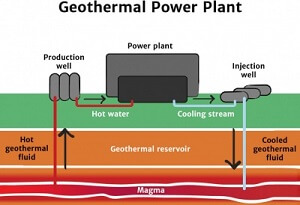How Much Does a Geothermal Power Plant Cost?
Last Updated on February 17, 2025
Written by CPA Alec Pow | Content Reviewed by ![]() CFA Alexander Popinker
CFA Alexander Popinker
Geothermal energy, which taps into underground reservoirs of steam and hot water, is one of the most environmentally friendly and sustainable renewable energy sources available today. Geothermal plants can provide constant baseload power with high availability factors and zero carbon emissions.
But many wonder – how much does it cost to build and run a geothermal power plant? In this guide, we’ll analyze the main cost components that factor into geothermal energy projects, from early exploration to plant construction and ongoing operations and maintenance.
We’ll also compare geothermal pricing against other renewable energy technologies like solar and wind.
How Much Does a Geothermal Power Plant Cost?
Constructing a brand-new geothermal power plant requires major upfront capital investment, with costs typically ranging from $2.5 million to $5 million per installed megawatt (MW) of generation capacity.
The bulk of these capital expenditures go towards drilling production wells and building the power plant itself. Location also plays a major role.
Exploration and Early Development
Before any wells can be drilled, developers must thoroughly survey the target area and assess the geothermal resource potential. These preliminary studies help size the plant and determine economic viability.
- Geological, geophysical, and geochemical surveys provide initial subsurface mapping and estimate resource temperatures and volumes. Costs for early-stage surveys often range from $1 million to $5 million per project.
- Exploratory and temperature gradient drilling creates a more accurate picture of geothermal conditions at depth. This stage can cost $2 to $5 million in additional expenses.
- Environmental and feasibility assessments ensure the project is permitted, economically viable, and able to secure financing. These studies add $500,000 or more in soft costs.
In total, early development costs frequently amount to $5 to $10 million before full-scale drilling commences.
Geothermal Well Drilling Costs
Drilling enough sufficiently deep production wells is essential for maximizing the geothermal resource yield. Well drilling accounts for 30% to 50% of the total plant construction budget.
- Individual geothermal production wells typically cost $2 to $4 million each to drill and case.
- The required well depth is site-specific and depends on subsurface temperatures. Wells over 2 km deep are common for enhanced geothermal systems (EGS).
- More complex geologies or drilling environments will increase per well costs. Most geothermal plants have 3 to 10 production wells.
With each well costing several million dollars, drilling represents one of the largest geothermal power plant expenditures.
Power Plant Construction Costs
Building the above-ground geothermal power generation facility is the other major plant capital cost.
- For dry steam plants, the main investments are steam turbines, generators, and structural foundations, costing around $2,000 to $4,000 per kW capacity.
- Flash steam and binary cycle plants require additional components like heat exchangers, pumps, condensers and cooling towers, ranging from $2,500 to $5,000 per kW.
- Plant costs also depend on the scale of the project. Small 5 to 10 MW facilities may cost $6,000 to $7,000 per kW, while larger 30 to 100 MW plants can average $2,000 to $3,000 per kW due to economies of scale.
Grid Interconnection and Infrastructure
Connecting the geothermal plant to the electrical grid and building supporting infrastructure adds 5% to 15% to the total capital budget:
- Transmission lines, transformers and substations to deliver electricity to customers cost around $150 to $500 per kW of capacity.
- Access roads, production pipelines, offices and maintenance buildings can add $100 to $250 per kW in ancillary project expenses.
- Remote plants far from existing transmission networks require more significant infrastructure investment.
While early development costs are highly site-specific, total capital costs for a new geothermal power plant range from $2,500 to $5,000 per kW, with drilling and power plant construction as the two largest cost centers.
HowStuffWorks notes that drilling wells is one of the most expensive parts of engineered geothermal systems (EGSs). Drilling a single well can cost between $5 million for a 2.5-mile deep well and $20 million for deeper wells at around 6.2 miles.
On Renovables Blog, it’s mentioned that building a geothermal plant involves significant upfront costs, including geological exploration and drilling, which can exceed millions of dollars per well—typically between $2 million to $7 million depending on depth and conditions.
The overall construction cost per installed megawatt generally ranges from $2 to $8 million, making small-scale plants around $20 to $50 million, while large projects can reach up to $500 million.
The Center for Sustainable Systems at the University of Michigan reports that capital costs for conventional geothermal power plants in the U.S. are approximately $2,500 per installed kW capacity. This aligns with data from UnderstandSolar, which also states an initial cost around this figure.
Lastly, Statista provides global context by noting that average installed costs worldwide have ranged from about 3,000 to 6,100 USD per kilowatt, with recent figures closer to approximately 4,589 USD/kW in 2023.
How Do Geothermal Power Plants Work?
Before looking at geothermal plant costs, it’s important to understand what geothermal energy is and how geothermal power facilities function.
Geothermal plants generate electricity by tapping into underground reservoirs of naturally heated water or steam. These geothermal resources are located deep beneath the earth’s surface, where high temperatures are continuously produced by the slow decay of radioactive particles in the planet’s core.
There are three main types of geothermal power plants:
- Dry steam plants utilize underground steam directly to turn turbine generators.
- Flash steam plants draw deep hot water into lower-pressure tanks, converting it to steam to drive turbines.
- Binary cycle plants transfer heat from geothermal water to a secondary working fluid, typically a low-boiling-point organic compound, which vaporizes to rotate turbines.
In all cases, the high-energy steam or working fluid spins turbine blades that activate generators, converting the geothermal heat into usable electricity. The spent steam or fluid is then cooled, condensed, and reinjected back into the geothermal reservoir to be reheated again.
Cost Components
Building and operating a geothermal power plant involves these key categories of capital and operational expenditures:
- Exploration and Resource Assessment
- Surveys to map potential underground geothermal reservoirs
- Exploratory and temperature gradient drilling
- Feasibility studies and environmental impact assessments
- Production Well Drilling
- Drilling sufficient production wells to optimize resource extraction
- Well casings, piping, and downhole pumps
- Power Plant Construction
- Geothermal steam turbines and generators
- Heat exchangers, condensers, and cooling towers
- Structural foundations and buildings
- Grid Connection Infrastructure
- Electrical substations, transformers, and transmission lines
- Access roads, pipelines, and distribution infrastructure
- Operation and Maintenance
- Ongoing electricity generation and distribution
- Monitoring subsurface temperatures and pressures
- Maintaining and repairing equipment
Operating Costs and Economics
You might also like our articles about the cost of tidal energy, solar energy, or hydroelectric energy.
In addition to major upfront capital costs, geothermal project developers must consider the long-term operating and maintenance expenses to generate positive project economics.
Operations and Maintenance Costs
Ongoing O&M costs for an active geothermal plant are estimated to range from:
- $0.01 to $0.03 per kWh for personnel, maintenance, repairs, and equipment upgrades.
- 3-5% of initial capital costs per year for more extensive wellfield and plant overhauls.
- $100,000 to $400,000 in annual maintenance costs per MW of installed capacity.
These expenses are relatively low compared to hydrocarbon fuels and contribute to geothermal energy’s excellent capacity factors of 85% to 95%.
Levelized Cost of Electricity
The levelized cost of electricity (LCOE) totals all capital and operating costs over a facility’s lifespan divided by total kWh generation.
- Geothermal energy offers a very competitive LCOE around $0.05 to $0.10 per kWh in high-resource areas.
- By comparison, wind and solar LCOE range from $0.04 to $0.12 per kWh. Fossil fuels usually cost $0.05 to $0.17 per kWh.
- Geothermal’s low long-term operating costs offset its higher upfront capital needs, making it cost-competitive.
Factors That Influence Plant Costs
 Several important variables impact the overall price tag for a geothermal energy project:
Several important variables impact the overall price tag for a geothermal energy project:
Resource Quality and Location
- Hotter subsurface temperatures over 200°C enable better power conversion efficiency and lower drilling costs.
- Locations like Iceland, Kenya and Indonesia have ideal natural geothermal conditions, reducing project development expenses.
- Building in remote or challenging terrain can double costs for drilling and infrastructure.
Type of Geothermal Technology
- Conventional hydrothermal resources provide cost-effective and predictable electricity generation.
- Enhanced geothermal systems (EGS) require more complex stimulation and circulation techniques that increase project costs.
- Emerging innovations like closed-loop EGS aim to lower geothermal costs by limiting water consumption.
Policy Incentives and Financing Support
- Government tax credits, feed-in tariffs and drilling subsidies can improve project economics substantially.
- Access to grants, loan guarantees and public co-investment reduces financing costs.
- Policy support allows developers to take on higher upfront costs and longer payback periods.
Geothermal Costs vs. Other Renewable Energy Sources
While geothermal requires significant upfront investment, its long-term generation costs and stability make it highly cost-competitive:
| Generation Type | Capital Cost per kW | Capacity Factor | LCOE per kWh |
| Geothermal | $2,500–$5,000 | 85-95% | $0.05–$0.10 |
| Solar PV | $1,000–$3,500 | 15-25% | $0.04–$0.12 |
| Wind | $1,200–$2,500 | 25-50% | $0.03–$0.12 |
| Coal | $900–$3,000 | 50-85% | $0.05–$0.17 |
| Natural Gas | $700–$1,500 | 50-90% | $0.05–$0.18 |
While geothermal requires high initial investment, its around-the-clock generation capability, low operating costs, and zero emissions make it a sustainable long-term energy solution.
Final Words
Constructing geothermal power plants entails substantial upfront capital costs, often ranging from $2.5–$5 million per megawatt of installed capacity. The majority of these costs go towards exploratory drilling and building the above-ground power generation facility.
However, geothermal energy offers excellent capacity factors of 85-95%, minimal operating expenses, and levelized electricity costs of just $0.05–$0.10 per kWh – on par with fossil fuels.
For countries with ideal subsurface hotspot resources, geothermal can provide affordable, reliable, 24/7 clean electricity for decades once plants are built. With supportive policies accelerating investment, geothermal energy is positioned to be a growing segment of the global renewable energy mix.
Answers to Common Questions
How much water does a geothermal plant use?
Geothermal plants use 3-5 gallons of freshwater per MWh generated. This is roughly one-third the water intensity of nuclear plants, one-quarter that of coal plants, and 7% that of natural gas plants. Binary plants recycle and reinject geothermal fluids in a closed-loop.
How much space is needed for a geothermal plant?
A 50 MW geothermal power plant uses around 50-150 acres of land, including the production wells and generation facility. The physical footprint is compact compared to equivalent solar or wind capacity. Plants can often be built on existing agricultural land.
What is the high cost of geothermal energy?
The main drawback of geothermal is the high upfront capital cost, which can disincentivize private investment. Drilling production wells and power plant construction costs typically range from $2,500-$5,000 per kW of capacity. Government incentives help offset these initial expenses.

Leave a Reply
Want to join the discussion?Feel free to contribute!